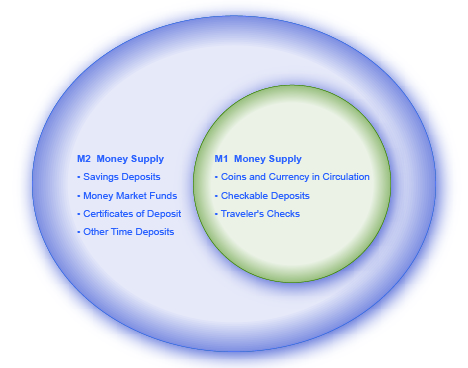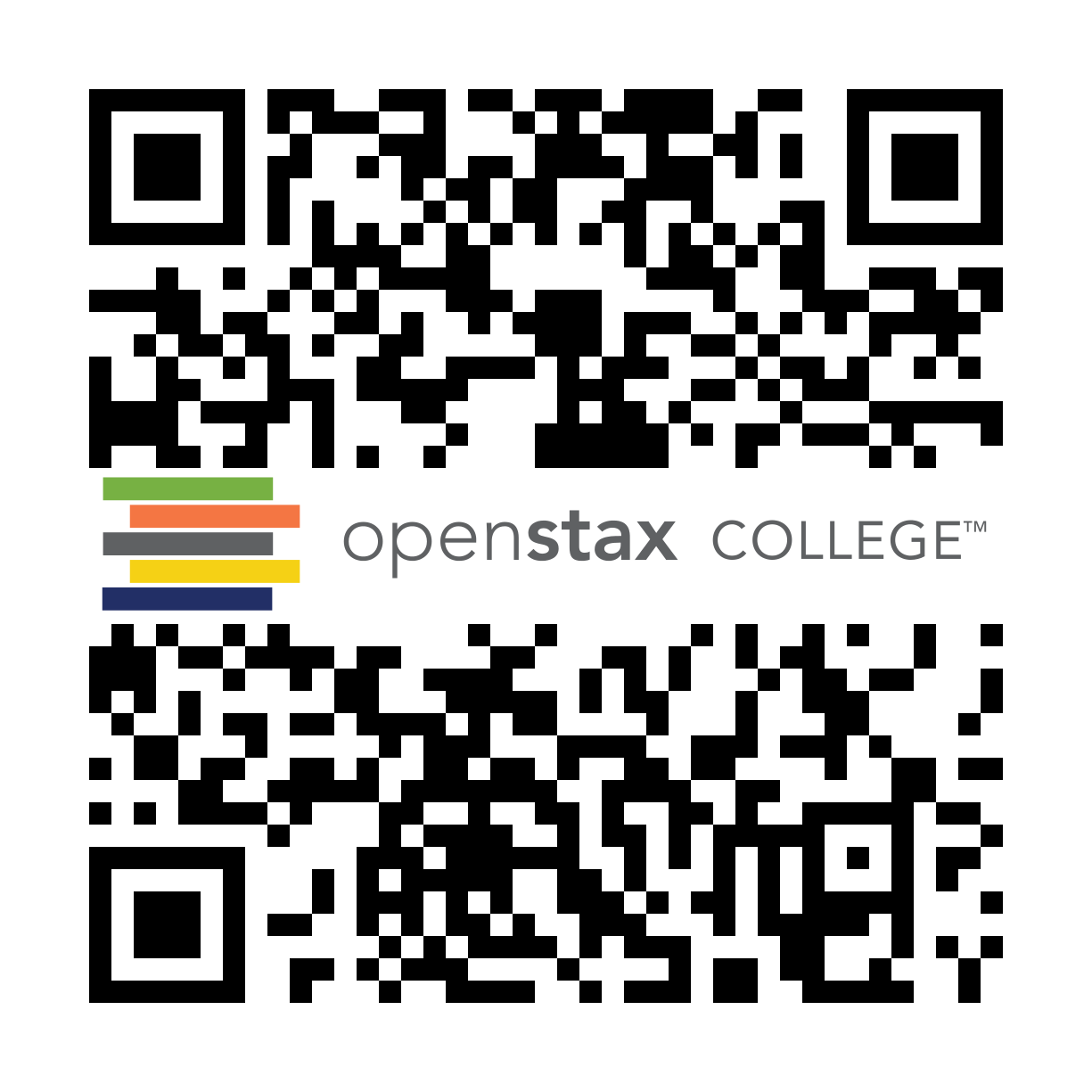
By the end of this section, you will be able to:
Cash in your pocket certainly serves as money. But what about checks or credit cards? Are they money, too? Rather than trying to state a single way of measuring money, economists offer broader definitions of money based on liquidity. Liquidity refers to how quickly a financial asset can be used to buy a good or service. For example, cash is very liquid. Your $10 bill can be easily used to buy a hamburger at lunchtime. However, $10 that you have in your savings account is not so easy to use. You must go to the bank or ATM machine and withdraw that cash to buy your lunch. Thus, $10 in your savings account is less liquid.
The Federal Reserve Bank, which is the central bank of the United States, is a bank regulator and is responsible for monetary policy and defines money according to its liquidity. There are two definitions of money: M1 and M2 money supply. M1 money supply includes those monies that are very liquid such as cash, checkable (demand) deposits, and traveler’s checks M2 money supply is less liquid in nature and includes M1 plus savings and time deposits, certificates of deposits, and money market funds.
M1 money supply includes coins and currency in circulation—the coins and bills that circulate in an economy that are not held by the U.S. Treasury, at the Federal Reserve Bank, or in bank vaults. Closely related to currency are checkable deposits, also known as demand deposits. These are the amounts held in checking accounts. They are called demand deposits or checkable deposits because the banking institution must give the deposit holder his money “on demand” when a check is written or a debit card is used. These items together—currency, and checking accounts in banks—make up the definition of money known as M1, which is measured daily by the Federal Reserve System. Traveler’s checks are a also included in M1, but have decreased in use over the recent past.
A broader definition of money, M2 includes everything in M1 but also adds other types of deposits. For example, M2 includes savings deposits in banks, which are bank accounts on which you cannot write a check directly, but from which you can easily withdraw the money at an automatic teller machine or bank. Many banks and other financial institutions also offer a chance to invest in money market funds, where the deposits of many individual investors are pooled together and invested in a safe way, such as short-term government bonds. Another ingredient of M2 are the relatively small (that is, less than about $100,000) certificates of deposit (CDs) or time deposits, which are accounts that the depositor has committed to leaving in the bank for a certain period of time, ranging from a few months to a few years, in exchange for a higher interest rate. In short, all these types of M2 are money that you can withdraw and spend, but which require a greater effort to do so than the items in M1 [link] should help in visualizing the relationship between M1 and M2. Note that M1 is included in the M2 calculation.

The Federal Reserve System is responsible for tracking the amounts of M1 and M2 and prepares a weekly release of information about the money supply. To provide an idea of what these amounts sound like, according to the Federal Reserve Bank’s measure of the U.S. money stock, at the end of February 2015, M1 in the United States was $3 trillion, while M2 was $11.8 trillion. A breakdown of the portion of each type of money that comprised M1 and M2 in February 2015, as provided by the Federal Reserve Bank, is provided in [link].
| Components of M1 in the U.S. (February 2015, Seasonally Adjusted) | $ billions |
| Currency | $1,271.8 |
| Traveler’s checks | $2.9 |
| Demand deposits and other checking accounts | $1,713.5 |
| Total M1 | $2,988.2 (or $3 trillion) |
| Components of M2 in the U.S. (February 2015, Seasonally Adjusted) | $ billions |
| M1 money supply | $2,988.2 |
| Savings accounts | $7,712.1 |
| Time deposits | $509.2 |
| Individual money market mutual fund balances | $610.8 |
| Total M2 | $11,820.3 (or $11.8 trillion) |
The lines separating M1 and M2 can become a little blurry. Sometimes elements of M1 are not treated alike; for example, some businesses will not accept personal checks for large amounts, but will accept traveler’s checks or cash. Changes in banking practices and technology have made the savings accounts in M2 more similar to the checking accounts in M1. For example, some savings accounts will allow depositors to write checks, use automatic teller machines, and pay bills over the Internet, which has made it easier to access savings accounts. As with many other economic terms and statistics, the important point is to know the strengths and limitations of the various definitions of money, not to believe that such definitions are as clear-cut to economists as, say, the definition of nitrogen is to chemists.
Where does “plastic money” like debit cards, credit cards, and smart money fit into this picture? A debit card, like a check, is an instruction to the user’s bank to transfer money directly and immediately from your bank account to the seller. It is important to note that in our definition of money, it ischeckable deposits that are money, not the paper check or the debit card. Although you can make a purchase with a credit card, it is not considered money but rather a short term loan from the credit card company to you. When you make a purchase with a credit card, the credit card company immediately transfers money from its checking account to the seller, and at the end of the month, the credit card company sends you a bill for what you have charged that month. Until you pay the credit card bill, you have effectively borrowed money from the credit card company. With a smart card, you can store a certain value of money on the card and then use the card to make purchases. Some “smart cards” used for specific purposes, like long-distance phone calls or making purchases at a campus bookstore and cafeteria, are not really all that smart, because they can only be used for certain purchases or in certain places.
In short, credit cards, debit cards, and smart cards are different ways to move money when a purchase is made. But having more credit cards or debit cards does not change the quantity of money in the economy, any more than having more checks printed increases the amount of money in your checking account.
One key message underlying this discussion of M1 and M2 is that money in a modern economy is not just paper bills and coins; instead, money is closely linked to bank accounts. Indeed, the macroeconomic policies concerning money are largely conducted through the banking system. The next section explains how banks function and how a nation’s banking system has the power to create money.
Read a brief article on the current monetary challenges in Sweden.

Money is measured with several definitions: M1 includes currency and money in checking accounts (demand deposits). Traveler’s checks are also a component of M1, but are declining in use. M2 includes all of M1, plus savings deposits, time deposits like certificates of deposit, and money market funds.
If you are out shopping for clothes and books, what is easiest and most convenient for you to spend: M1 or M2? Explain your answer.
The currency and checks in M1 are easiest to spend. It is harder to spend M2 directly, although if there is an automatic teller machine in the shopping mall, you can turn M2 from your savings account into an M1 of currency quite quickly. If your answer is about “credit cards,” then you are really talking about spending M1—although it is M1 from the account of the credit card company, which you will repay later when you credit card bill comes due.
For the following list of items, indicate if they are in M1, M2, or neither:
What components of money are counted as part of M1?
What components of money are counted in M2?
Explain why you think the Federal Reserve Bank tracks M1 and M2.
The total amount of U.S. currency in circulation divided by the U.S. population comes out to about $3,500 per person. That is more than most of us carry. Where is all the cash?
If you take $100 out of your piggy bank and deposit it in your checking account, how did M1 change? Did M2 change?
Federal Reserve Statistical Release. November 23, 2013. http://www.federalreserve.gov/RELEASES/h6/current/default.htm#t2tg1link.

You can also download for free at http://cnx.org/contents/69619d2b-68f0-44b0-b074-a9b2bf90b2c6@11.346
Attribution: